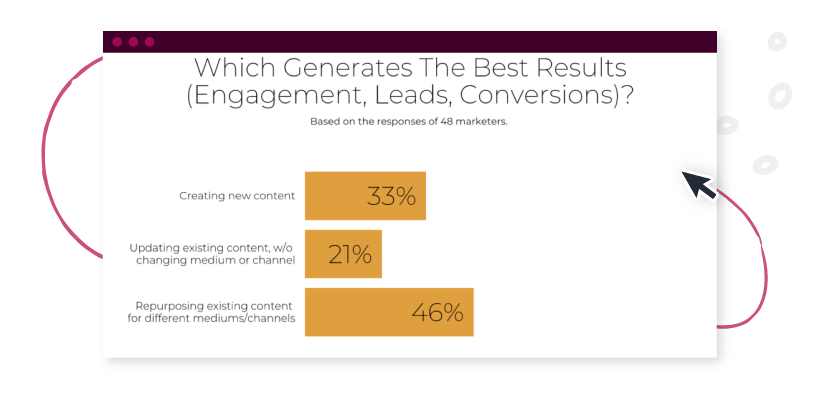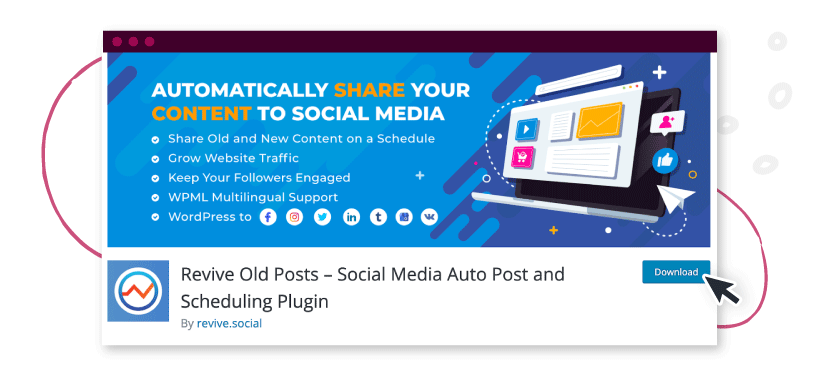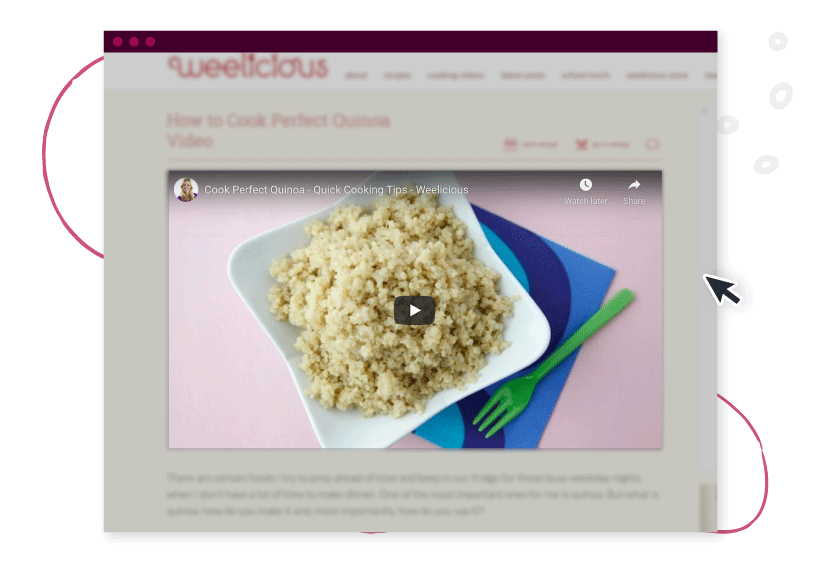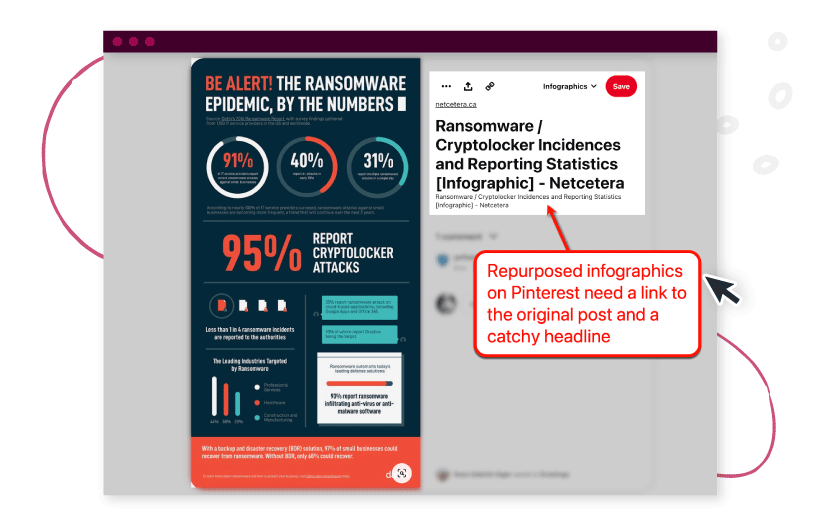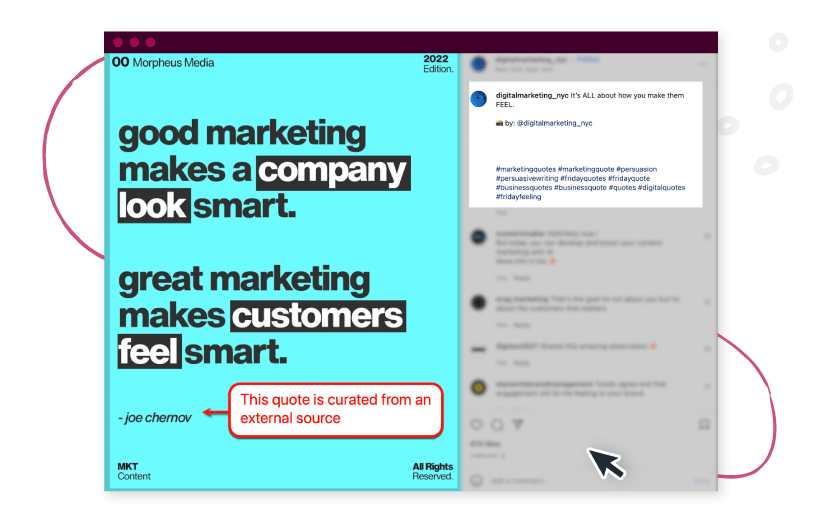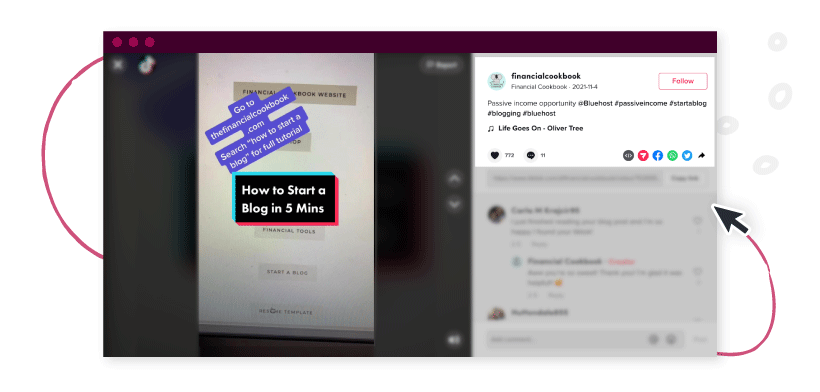Content repurposing enables brands to squeeze the most value from their ever-growing content library.
There’s no need to spend hours on content research, creation, and publishing. If you have a collection of old posts gathering virtual dust, content repurposing could be the key to unlocking your website’s true SEO and traffic potential.
This post will show you how.
What is content repurposing?
Content repurposing is the practice of reusing parts or the entirety of existing content to create something better—often using a different format.
It allows marketers to reach new audiences with fewer resources compared to creating content from scratch, and it’s an absolutely vital part of any content marketing strategy.
Why do you need to repurpose content?
Here are some of the benefits of repurposing your content.
1. Save time
According to statistics, the average full-length blog post takes three hours and 48 minutes to create.
Content repurposing leverages the research, writing, and editing that you or your team already did. That saves you hours of time and makes it easy to scale up your content strategy and traffic generation.
2. Revive old posts
Every site has a few top-performing posts and a lot of articles that don’t get that much traffic.
With repurposing, old content can be given a second, third, or even fourth chance to get the attention it deserves. Brands only need to use the right strategies to refresh each piece.
3. Spread link equity
Done right, repurposing can help old posts get fresh backlinks from authoritative sources. This can elevate your website’s overall authority rank and could have a site-wide impact on rankings.
4. Reach new audiences
One of the main reasons why content fails to meet expectations is because of ineffective distribution.
Repurposing can fix both issues by converting old content to a new format and publishing it to the right channels. This can help any brand reach a wider audience, including users that prefer specific content types.
5. Signal content freshness
Content freshness refers to recently updated or newly published content.
Repurposing or revising your content sends a signal to search engines, especially if you’ve added up-to-date and relevant information. This improves your content’s likelihood of ranking and getting more clicks from searchers.
Content creation vs. content repurposing
Many content creators reuse and repackage information from older sites into new pieces. While they are re technically ‘recycling’ content, proper content repurposing is an entirely different ball game. Content creation heavily relies on topic ideation and keyword research.
A survey revealed that 46% of marketers believe that repurposing content is more effective than creating new content from square one. 65% also agree that it is more cost-effective than building new content or performing minor updates on existing posts.
Image Source: ReferralRock.com
How to repurpose content for SEO
Remember the following steps to make the most out of content repurposing:
1. Set your goals
Repurposing should be done with a well-defined purpose.
First, you need to come up with the goal for each piece of content. Do you want it to start ranking for a specific keyword? Do you want to recover lost rankings on existing keywords?
Understanding your goal will drastically modify your approach to repurposing. This includes the content you’ll recycle, the tools you’ll use, and the metrics you will track.
2. Explore your content library
Use your website’s content library as a starting point when looking for content to repurpose. Doing so lets you accomplish multiple content repurposing goals in one go.
For example, if you need more traffic from social media, you take an old post and create an infographic for it, which you can then publish on Pinterest and other social media platforms. By linking back to the original post, you can bring it back to life by sending it some fresh traffic.
3. Think about content curation
You can also repurpose curated content. Just look for a unique angle to present the repurposed content and ensure your angle aligns with your marketing goals.
Content curation methods include searching for relevant content from third-party sources, like social media and other blogs, and sharing them with your audience.
With content repurposing, there needs to be a component of creativity that add your brand’s flavor to the curated post. Instead of simply sharing curated content as is, use it to create something new by using a different format or adding your own insights to the mix.
4. Check your target audience
It’s also important to be in tune with the content preferences of your target audience when you’re repurposing content.
- What are they searching for? Which content formats get their attention the most?
- Where do they prefer to see such content?
- If you’re repurposing old content, what do the comments say?
Answering these questions will help you develop a repurposing strategy that can guarantee positive results.
Proven tips for repurposing your blog posts
Here are some ideas on how to repurpose content for your blog.
1. Convert text-based blog posts into visuals
The simplest way to repurpose old content is to extract the key takeaways, build an infographic, and add supporting copy.
For example, if you publish a compilation of the latest statistics in your niche, copy the headers and plug them into an infographic. You can also copy or write a few sentences as supporting text to enable your new content to deliver value on its own.
Infographics function as natural link magnets for other content creators who need data to back up their claims. They’re also powerful linkable assets when publishing guest posts on high-authority websites.
Another type of visual content you can use for repurposing would be slideshow presentations. After creating an infographic, slice it into smaller parts and use them as slides.
2. Streamline content repurposing with the right tools
WordPress users can take advantage of content repurposing WordPress plugins that can automate certain tasks. For example, there’s a free WordPress plugin called Revive Old Posts that automatically shares old and new posts to your social media pages.
Image Source: WordPress.org/Plugins
Some plugins can help you find content related to a top-performing post, which should be added to your repurposing queue. This makes it easy to find posts that tackle high-demand topics but lack effective exposure and promotion.
3. Turn how-to guides into tutorial videos
If you have a tutorial post or a “how-to” guide that’s performing well, you can amplify its success even further by turning it into a video.
Video tutorials aren’t just more engaging and shareable than text-based posts, but they’re also easier to digest and more effective in terms of information retention.
After repurposing your content into a video, share the clip on video-sharing networks, such as Vimeo and YouTube. The video can also be embedded directly in the original blog post, which will boost content freshness and maximize reader engagement on the page.
Image Source: Weelicious.com
Just like infographics, videos are also considered link-worthy assets. Another benefit is that they boost your SEO when you publish them on YouTube, as they help you rank in Google video results.
4. Combine tutorial videos into an online course
Repurposing videos into a full-on online course lets you monetize your website content. If things go well, it can also help you establish yourself (or your brand) as an authority in your niche.
Be on the lookout for other content repurposing opportunities that can be valuable to your online course. With a little creativity, blog posts can be converted into templates, cheat sheets, and other resources that your students can download.
5. Convert long-form guides into ebooks
“Ultimate guides” that are thousands of words long can be repurposed into an eBook, which you can distribute elsewhere or sell as premium content.
If you plan to do the latter, make sure your ebook is a beefed-up version of your blog post. Add more actionable steps and incorporate better visuals to make it more valuable.
Now let’s talk about repurposing your content on social media.
How to repurpose content for social media
Content repurposing accelerates the content creation process, whereas social media marketing pushes content in front of as many people as possible—in less time.
Combining the two lets you benefit from the scalability of repurposing and the reach of social media.
Here are some ideas:
1. Promote infographics on Pinterest
Infographics are huge on Pinterest, which is why a lot of brands share repurposed infographics on the platform. Apart from the infographic, the key ingredients to this strategy are a captivating headline and a link back to the original post.
Image Source: Pinterest.com, @netcetera.ca
2. Share image quotes on Instagram
Which is better, curated or created content?
Well, repurposed content gives you the best of both worlds so why not opt for repurposed content, instead?
A perfect example is an image quote on Instagram, which curates wisdom from other sources and publishes it as original content.
Image Source: Instagram.com, @digitalmarketing_nyc
3. Publish short-form video tutorials on TikTok and YouTube
Another strategy is to connect to new audiences by repurposing tutorials into short-form videos on platforms like TikTok and in new formats like YouTube Shorts and Instagram Reels.
Unlike traditional video content, short-form videos don’t require expensive video equipment. A smartphone has enough functions and recording capabilities to create short-form videos that can garner hundreds of views.
Image Source: TikTok.com, @financialcookbook
Best tools for content repurposing
Looking for the quickest way to start repurposing? Below are some of the best content repurposing tools that require little to no training to use:
- Canva: Create image quotes, simple animations, infographics, and other eye-catching visuals using a drag-and-drop interface.
- SlideShare: Upload and share slideshow presentations with your online audience.
- VEED: Put together clips, add subtitles, insert voiceovers, and use effects to create videos for social media.
Repurposing content for SEO: FAQs
1. Does updating your content improve rankings?
Yes, updating old content lets you generate a surge of traffic and signal content freshness to Google. Both can help improve your content’s search engine rankings.
2. What is fresh content in SEO?
Fresh content includes new, revamped, or regularly updated content. Freshness is a major ranking factor when it comes to trending topics, news, sports-related niches, and more.
3. How does Google measure content freshness?
Since the Caffeine update, Google has used an efficient indexing system that looks at a number of factors like page inception date, amount of change, and rate of page change to measure content freshness. The Caffeine indexing system was designed to help the search engine present the most recent and relevant search results.
4. What are the benefits of repurposed content?
The biggest benefits of repurposed content are as follows:
- Scale up your content marketing efforts by publishing posts more efficiently
- Reach new audiences with specific content preferences
- Save time and money on content research, development, and optimization
- Increase user engagement by diversifying the content experience
- Bring traffic and links to old posts
Repurpose content to perfection today
Although content repurposing is easy, it can still require hours of work, especially when you have truckloads of content to repurpose.
You also need to have the right tools and proven strategies to get meaningful results out of your content repurposing initiatives.
Plenty of brands outsource their content repurposing needs to get fast, reliable, and scalable results. Talk to a content specialist today if you’re looking for a time-tested content repurposing service.


